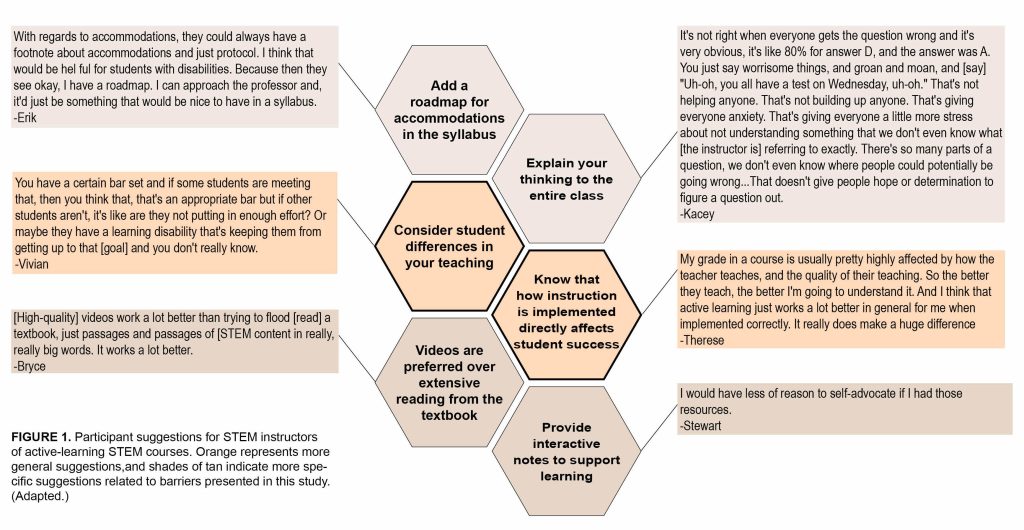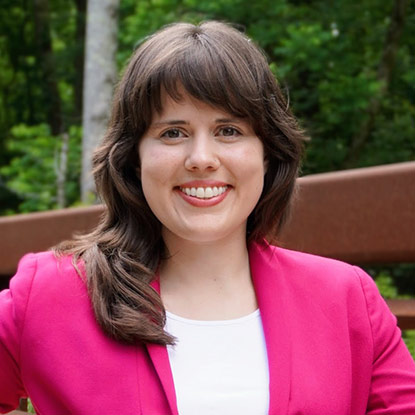Building a Better Learning Experience: Using Student Data to Enhance Active Learning for Neurodivergent Students
On Wednesday, May 14, Dr. Mariel Pfeifer presented the findings of her research exploring how neurodivergent students experience active learning.
Experiencing Active Learning as a Neurodivergent Student
As a discipline-based education researcher (DBER), Dr. Pfeifer addresses research questions related to teaching and learning within a specific discipline. Her doctorate is in biology, but her research focuses on educational practices across STEM fields.
The research Dr. Pfeifer presented from her 2023 study investigated how active-learning practices influence the learning and self-advocacy experiences of neurodivergent students, specifically those with Attention Deficit Hyperactivity Disorder (ADHD) and/or a Specific Learning Disability (SLD) such as dyslexia (reading), dysgraphia (writing), or dyscalculia (math) in undergraduate STEM courses. Because little was known about how neurodivergent students experience active-learning practices, the researchers sought to gain insight into the students’ perceptions of active learning in STEM courses. Dr. Pfeifer interviewed 25 STEM majors with ADHD or SLD about their experiences with active-learning practices and conducted the analysis with a research team consisting of individuals who identified as neurodivergent and individuals who did not.
Dr. Pfeifer emphasized that these results aim to understand student perceptions of active learning rather than to evaluate the efficacy of any specific active learning approach. The data revealed that, overall, most participants reported learning best in an active-learning environment. However, participants also shared varied perceptions of active learning, sometimes even within the same class. Some said that active learning allowed them to better engage with the content, while others reported that it felt stressful or that they personally disliked it.
When Active Learning Hinders Student Learning
Since the reasons why active learning was perceived as supportive of participants’ learning were similar to those in other active-learning studies, the research team was particularly interested in understanding when active-learning practices hindered learning for neurodivergent students. A pattern emerged from their analysis: whether an aspect of active learning was perceived as hindering or not depended on how the instructor implemented the strategy rather than the specific strategy itself.
The research team identified seven influential aspects of active learning named by the participants:
- Audience response systems (real-time survey tools often referred to as “clickers”)
- Group work
- Flipped courses
- Course materials
- Instructor reveals thinking (how an instructor provided feedback on particular types of questions and how they expect students to engage)
- Course structure (policies and frequent assignments)
- Environment (physical space and classroom climate)
Below are examples of instances where the implementation of an aspect of active learning was perceived as hindering the students’ learning processes.
Aspect of Active Learning
Hindering perception of learning
Clickers
When an instructor shares a flood of responses to a clicker activity
Group work
When participants with an LD that affects reading/writing were assigned to be a reader or writer role during group work
Course materials and structure
When participants were asked to engage with reading/media before class without having any prior exposure.
Instructor reveals thinking
When an instructor does not provide feedback on their thinking
Course environment
The way an instructor utilizes space, (ex. SCALE-UP or TEAL classrooms ) can be distracting
Dr. Pfeifer also shared some of the teaching suggestions that emerged from the participant interviews (see Figure 1). For the full list of suggestions collected from the interviews, see Pfeifer et al., 2023. CBE-Life Sciences Education.

Implementing Active Learning That Supports All Students
Based on this data, Dr. Pfeifer offered teaching tips and resources for how to implement active-learning practices that are perceived as supportive for neurodiverse students:
Design courses with Universal Design for Learning (UDL)
- Multiple means of engagement, representation, and action & expression. For more information:
Proactively plan for student accommodations
- Ideally, design courses so students don’t need accommodations
- Have plans in place for frequently-used accommodations, for example:
- Extended time: in-class quizzes, graded clicker questions, etc.
- Note-taking: provide students with fill-in-the-blank notes that they can choose to use or not
- Flexible attendance: how to access learning opportunities
- Share accommodation plans with students
See Gin et al., (2020) for more information.
Ask students about their access needs without necessarily naming disability accommodations
- Access refers to a learning space that provides everything that all people need to fully participate in the space/activity. Examples:
- What do you need in order to do your best work in this class?
- Surveys, checking in with students throughout the semester, etc
See Reinholz and Ridgway (2021) for more information.
Consult resources for the implementation of active learning
Dr Pfeifer is currently working with additional data from another study of neurodivergent students and active learning, so more information on this topic is forthcoming.
List of additional resources for instructors provided by Dr. Pfeifer.

About the Speaker
Mariel Pfeifer is an Assistant Professor of Biology at the University of Mississippi. She is dedicated to promoting access to STEM fields for students and faculty with disabilities. Mariel earned her Ph.D. in Plant Biology from the University of Georgia, where she received both an NSF Graduate Research Fellowship and an ARCS Foundation award. As a trained biology education researcher and cell biologist, she aims to leverage her expertise in research, teaching, and mentoring to help eliminate barriers in STEM education.

